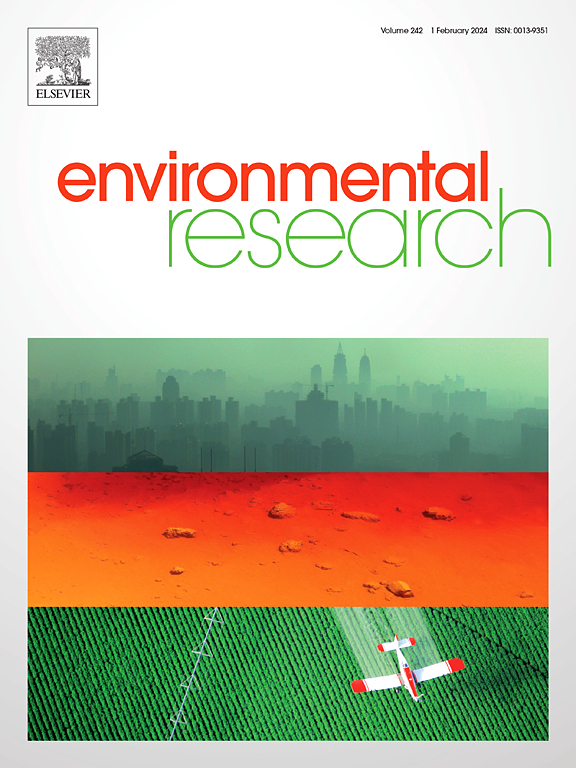Luminescent iron phthalocyanine organic polymer nanosheets with space-separated dual-active sites for the detection and photocatalytic reduction of Cr(Ⅵ) from wastewater
IF 7.7
2区 环境科学与生态学
Q1 ENVIRONMENTAL SCIENCES
引用次数: 0
Abstract
Cr(Ⅵ) residues in livestock and poultry wastewater are a rising concern for human health and biotic environments. For the removal of Cr(Ⅵ), its simultaneous reduction and adsorption represents a sustainable and efficient strategy. Herein, iron nodes on covalently bonded two-dimensional phthalocyanine organic polymer (PcOP-Fe) nanosheets with space-separated dual-active sites are developed for the simultaneous detection and removal of Cr(VI) from wastewater. In the FeN4 structure of PcOP-Fe nanosheets, Fe acts as an electron capture center, effectively facilitating the accumulation of photogenerated electrons and transferring them to Cr(VI), thereby achieving its photocatalytic reduction. Meanwhile, pyrrolic nitrogen provides excellent adsorption sites, enabling the adsorption of Cr(III) or Cr(0). Fe accumulates the photogenerated electrons from pyrrole N and transfer them to Cr(Ⅵ). The formation of N-Cr(Ⅲ) bonds causes a space-separation between Cr(Ⅵ) and Cr(III). In addition, PcOP-Fe can be used for a Cr(Ⅵ) detection agent. The photoluminescence intensity decreases linearly with increasing Cr(Ⅵ) concentration from 80 μM to 2 mM, with a limit of detection of 0.18 μM. The PcOP-Fe nanosheets exhibit good Cr(Ⅵ) detection and reduction performance in livestock and poultry wastewater, suggesting their suitability for practical sensing applications. Thus, the PcOP-Fe nanosheets with space-separated dual-active sites are promising for the simultaneous detection and removal of Cr(Ⅵ) in water treatment processes.
具有空间隔离双活性位点的发光铁酞菁有机聚合物纳米片,用于检测和光催化还原废水中的铬(Ⅵ)。
畜禽废水中的铬(Ⅵ)残留物对人类健康和生物环境的影响日益严重。为了去除铬(Ⅵ),同时还原和吸附铬(Ⅵ)是一种可持续的高效策略。本文开发了共价键合的二维酞菁有机聚合物(PcOP-Fe)纳米片上的铁节点,具有空间隔离的双活性位点,用于同时检测和去除废水中的六(Ⅵ)铬。在 PcOP-Fe 纳米片的 FeN4 结构中,Fe 充当电子捕获中心,有效促进光生电子的积累并将其转移到 Cr(VI),从而实现光催化还原。同时,吡咯烷酮氮提供了良好的吸附位点,可吸附 Cr(III) 或 Cr(0)。铁聚集吡咯氮光生成的电子,并将其转移到 Cr(Ⅵ)。N-Cr(Ⅲ) 键的形成导致了 Cr(Ⅵ) 和 Cr(III) 之间的空间分隔。此外,PcOP-Fe 还可用作铬(Ⅵ)的检测剂。从 80 μM 到 2 mM,光致发光强度随 Cr(Ⅵ)浓度的增加而线性降低,检测限为 0.18 μM。PcOP-Fe 纳米片在畜禽废水中表现出良好的 Cr(Ⅵ)检测和还原性能,表明其适合实际传感应用。因此,具有空间隔离双活性位点的 PcOP-Fe 纳米片有望在水处理过程中同时检测和去除铬(Ⅵ)。
本文章由计算机程序翻译,如有差异,请以英文原文为准。
求助全文
约1分钟内获得全文
求助全文
来源期刊

Environmental Research
环境科学-公共卫生、环境卫生与职业卫生
CiteScore
12.60
自引率
8.40%
发文量
2480
审稿时长
4.7 months
期刊介绍:
The Environmental Research journal presents a broad range of interdisciplinary research, focused on addressing worldwide environmental concerns and featuring innovative findings. Our publication strives to explore relevant anthropogenic issues across various environmental sectors, showcasing practical applications in real-life settings.
 求助内容:
求助内容: 应助结果提醒方式:
应助结果提醒方式:


